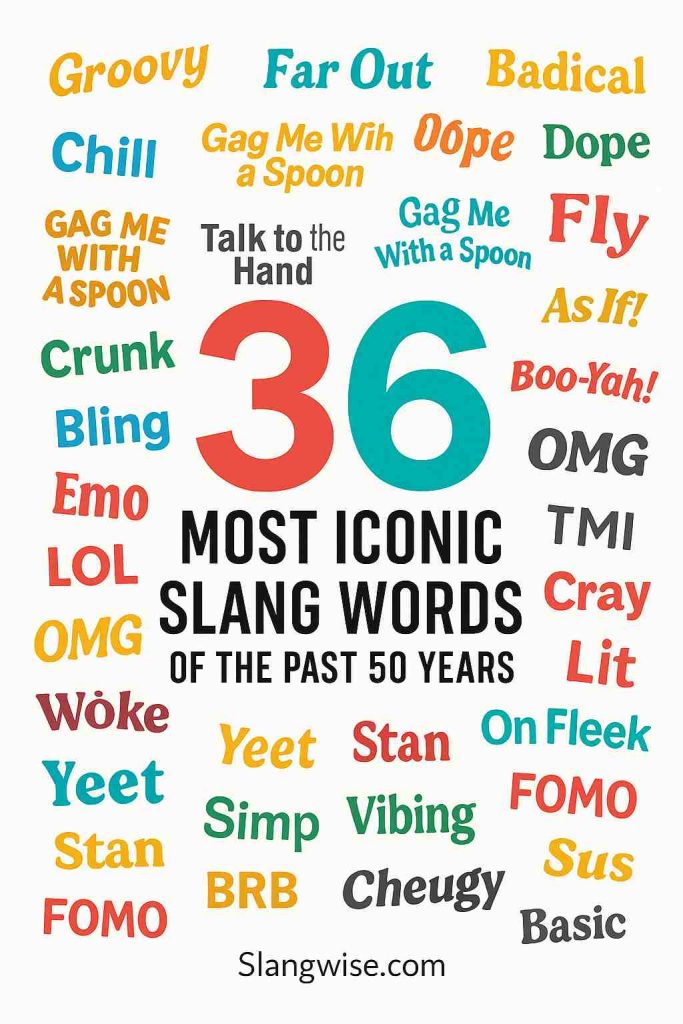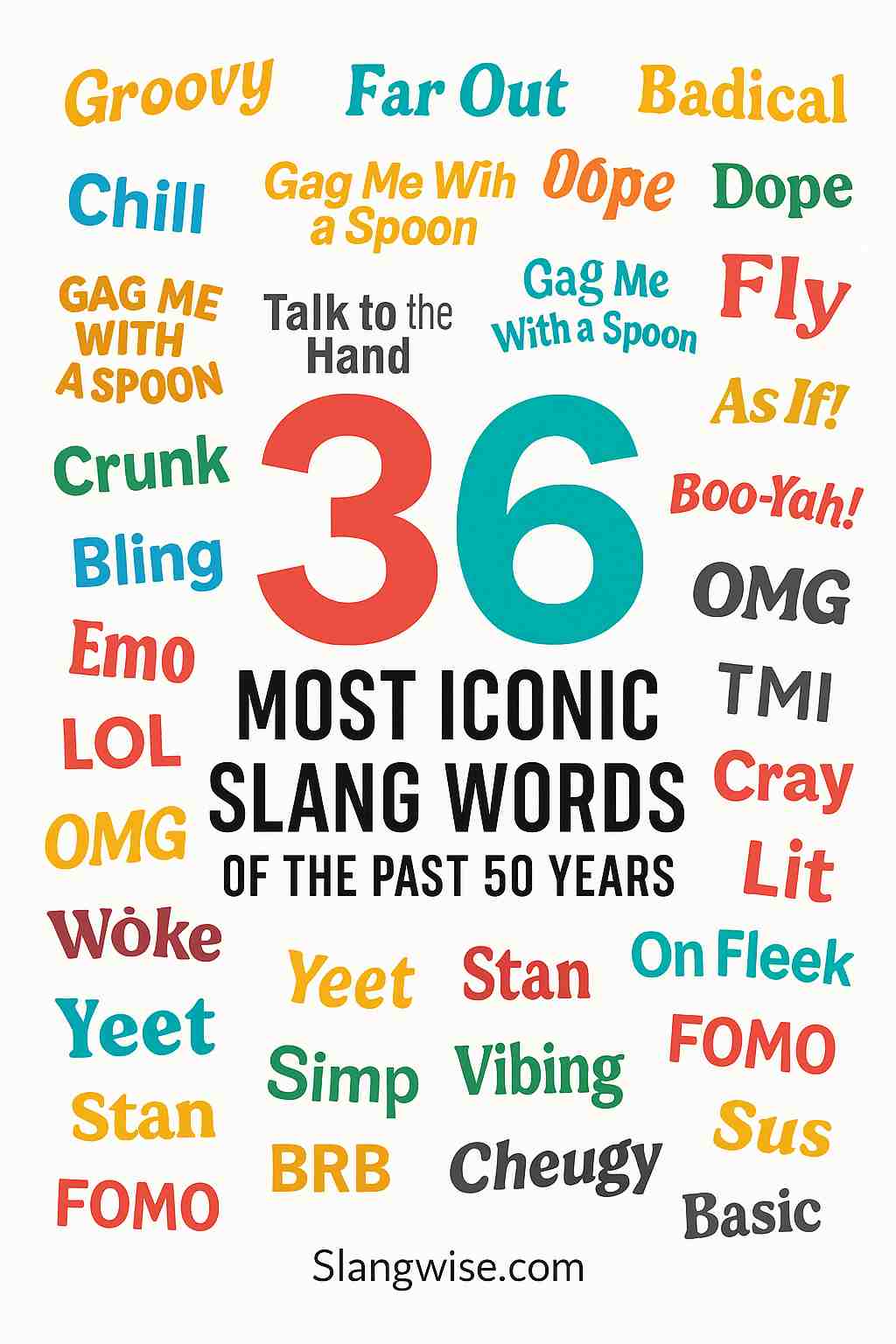
Slang Words moves fast. In the last fifty years, new slangs have appeared, spread quickly, and sometimes vanished just as fast.
These words aren’t random; they reflect changes in music, fashion, technology, and social attitudes.
By learning which terms rose to the top, we can trace how each generation communicated, what it valued, and how culture shifted over time.
In this post, I’ve researched and written the 36 most iconic slang words from the 1970s through today.
I considered and chose each slang term for its lasting impact, whether it shaped everyday speech, marked a cultural moment, or crossed from niche groups into the mainstream.
You’ll see how a surfer’s “radical” became a global compliment, how online abbreviations like “LOL” transformed our conversations, and how gamer lingo such as “sus” slipped into daily use.
I got the understanding that studying these words gives us insight into our collective history. As you read, consider how each slang term reflects its era’s technology, art, and social concerns.
By the end, you’ll have a clear picture of 50 years of changing language,and a deeper understanding of the forces that drive it.
Table of Contents
Key Takeaways
- Slang Words reflect cultural shifts, capturing changes in music, fashion, technology, and social attitudes over time.
- Many iconic words began in niche communities, surf, skate, hip-hop, gaming, and then spread into mainstream speech.
- Digital communication accelerated slang adoption: acronyms like LOL and OMG moved from chatrooms into everyday conversation.
- Social media and viral platforms (Vine, TikTok) can rapidly popularize new terms, as seen with “on fleek,” “yeet,” and “sus.”
- Slang evolves and fades as it loses its insider appeal, terms like “groovy” or “cheugy” mark generational identities and signal belonging.
38 Most Popular Slang Words of the past 50 years.
1. Groovy (1970s)
I remember first hearing “groovy” in old movie clips of disco dancers and bell-bottom jeans.
It meant “cool” or “excellent,” and it perfectly captured the laid-back, peace-and-love vibe of the ’70s. When you said “That’s groovy,” you were signing on to an easygoing, creative moment.
Slangwise Tip: It shows how a single jazz-era term found new life in a totally different scene.
2. Far Out (1970s)
“Far out” felt like a mini-time machine to outer space, or at least to a pink-and-purple lava lamp universe.
Whenever something surprised or amazed you, a wild concert, a psychedelic poster; you’d say, “Far out, man.”
Slangwise Tip: It reminds us that language can expand our imagination.
3. Chill (Out) (1970s)
Before “chill” became a millennial staple, it was the ’70s way of saying, “Stop stressing.”
Telling someone to “chill out” wasn’t just playful advice, it was part of a broader call to slow down and reject rigid norms.
Slangwise Tip: It’s proof that good advice never goes out of style.
4. Radical (1980s)
Some of us grew up watching skate-and-surf videos where every ollie or kickflip was met with “radical!” (or “rad,” for short).
It meant “extremely cool” or “amazing,” and it fit the decade’s love of bold moves and bright colors.
Slangwise Tip: It shows how sports culture can reshape everyday speech.
5. Bogus (1980s)
“Bogus” was the perfect slam, anything corny or unfair earned that label.
My favorite example? When Bill & Ted’s car got stolen, they didn’t just say “That’s unfair.” They said, “That is bogus.”
Slangwise Tip: It captures 80s movie-goofball energy in one punchy word.
6. Dope (1980s)
I first heard “dope” in early hip-hop tracks. It didn’t mean drugs; it meant “awesome.” When people called your mixtape or jacket “dope,” it was high praise.
Slangwise Tip: It’s an early example of how Black culture reshapes language for new generations.
7. Gag Me With a Spoon (1980s)
Valley Girl talk brought us this over-the-top expression of disgust.
Saying “gag me with a spoon” was a fun way to show you were totally unimpressed.
Slangwise Tip: It reminds us that slang can be delightfully theatrical.
8. Psych! (1980s)
“Psych!” was the original prankster’s catchphrase. You’d build someone up, “I got tickets to the concert…”, then hit them with a quick “psych!”
Slang that plays with our expectations always cracks me up.
Slangwise Tip: It proves that some of the best slang is just good, clean fun.
9. Fly (1990s)
By the time the ’90s rolled around, “fly” meant you were stylish and confident. From R&B tracks to sitcoms like The Fresh Prince, calling someone “fly” was the ultimate compliment.
Slangwise Tip: It shows how fashion and music can give words lasting power.
10. Da Bomb (1990s)
When something was truly top-notch, it was “da bomb.” I used to hear it in rap lyrics and even in commercials.
It was the decade’s way of saying, “This is the best of the best.”
Slangwise Tip: It blends a sense of explosive excitement with pure praise.
11. Talk to the Hand (1990s)
Ever needed a break from someone’s rant? Talk to the hand was your go-to. Martin Lawrence popularized it on TV, and teens everywhere perfected the “hand-in-face” pose.
Slangwise Tip: It’s pre-meme clapback energy, short, sassy, and universally understood.
12. As If! (1990s)
Thanks to Clueless, as if! became the ultimate eye-roll response. Whether someone asked you to prom or offered you a boring chore, as if! said it all without another word.
Slangwise Tip: It’s a masterclass in economy, three syllables, total dismissal.
13. Boo-Yah! (1990s)
You’d shout boo-yah! after scoring in sports, winning a video game, or just feeling victorious. It’s the era’s mic-drop moment, every time.
Slangwise Tip: It captures pure, unfiltered celebration.
14. Crunk (2000s)
Lil Jon didn’t just make music, he coined a vibe. Crunk meant amped-up energy, loud beats, and non-stop partying. When the DJ yelled “get crunk,” you knew the night was on fire.
Slangwise Tip: It shows how a single artist can redefine an entire’s decade slang.
15. Bling (2000s)
MTV Cribs and hip-hop videos turned bling into an international word for flashy jewelry and wealth. Soon, anyone with a gold chain could flex with “Check my bling.”
Slangwise Tip: It’s proof that pop culture can vault a niche term into the dictionary, literally.
16. Emo (2000s)
Short for “emotional,” emo described a music genre and a whole aesthetic, dark eyeliner, tight jeans, and lyrics about heartbreak. It was a generation’s anthem.
Slangwise Tip: It illustrates how one word can define a style, a mood, and a subculture.
17. LOL (2000s)
Once confined to chatrooms, LOL broke free into spoken language. You’d laugh out loud, or just mutter “lol”, even when you weren’t online.
Slangwise Tip: It’s the first major proof that digital shorthand can cross over into real-world speech.
18. OMG (2000s)
OMG followed LOL from forums to phone calls to face-to-face convos. It’s the ultimate expression of surprise or excitement in four characters.
Slangwise: It shows how brevity wins, texting culture changed our speech patterns forever.
19. TMI (2000s)
Too much information! Perfect for when your friend shared every detail of their latest date. It was equal parts warning and gentle roast.
Slangwise Tip: It’s practical, punchy, and still in heavy rotation, proof that some acronyms stick.
20. Cray (2000s)
Shortened from “cr*zy” and popularized by Kanye West, cray was the decade’s shorthand for something wild or outlandish.
It paved the way for other clipped forms like basic → bas and seriously → srsly.
Slangwise Tip: It marks the peak of text-style grammar invading everyday talk.
21. Lit (2010s)
Originally Black vernacular meaning “intoxicated,” lit exploded on social media to mean “hyped,” “amazing,” or “on fire” (in a good way).
From party recaps to concert hype posts, if the energy was high, it was lit.
Slangwise Tip: It shows how reclaiming and repurposing a term can give it a whole new life.
22. On Fleek (2010s)
In 2014, Kayla Newman’s Vine about perfect eyebrows went viral, and so did “on fleek,” meaning flawless.
Soon it described everything from makeup to outfit choices to life itself.
Slangwise Tip : It’s a reminder that one six-second video can reshape the language landscape.
23. Woke (2010s)
Woke started in Black activist circles as shorthand for awareness of racial and social injustice (“stay woke”).
As it entered mainstream use, it became shorthand for any progressive stance, sometimes earnestly, sometimes ironically.
Slangwise Tip: It underscores how slang can carry serious weight and spark important conversations.
24. Yeet (2010s)
Yeet began as a celebratory exclamation when throwing something (“I yeeted that ball!”) and quickly morphed into a general shout of excitement or approval. It’s flexible, chaotic fun.
Slangwise Tip: It’s pure, unfiltered internet energy, nonsensical yet perfectly expressive.
25. Stan (2010s)
From Eminem’s dark fan-fiction song “Stan” to everyday use, stan means obsessive fandom or passionate support (“I stan that artist”).
It captures both adoration and a wink at our own intensity.
Slangwise Tip: It bridges pop culture history with modern fan communities.
26. FOMO (2010s)
Fear of missing out became ubiquitous as photo-perfect social feeds made us all question whether our lives were exciting enough. FOMO captured that anxious, itch-to-scroll feeling.
Slangwise Tip : It highlights how social media reshapes our emotional vocabulary.
27. Sus (2020s)
Thanks to the game Among Us, calling someone sus (short for suspicious) became a way to call out shady behavior, online or off. It’s quick, playful, and now part of everyday chat.
Why I love it: It shows how gaming culture can inject fresh slang into real life.
28. Simp (2020s)
Once an insult for men who seemingly over-prioritize someone else’s attention, simp evolved into a semi-ironic term for anyone who goes out of their way for someone they admire (“I simp for my best friend.”).
Slangwise Tip: It illustrates how community usage can soften and reshape a word’s meaning.
29. Vibing (2020s)
From “vibe check” skits to chill playlists, vibing means immersing yourself in a particular mood or energy.
Whether you’re “good vibes only” or “vibe checking” a room, it’s all about the feel.
Why I love it: It’s the perfect slang for an era craving calm amid chaos.
30. Rizz (2020s)
A newcomer from TikTok, rizz (short for charisma) refers to someone’s flirting or charm game (“He’s got mad rizz.”).
It’s already sparked challenges, tutorials, and viral duets.
Slangwise Tip: It’s proof that TikTok isn’t just for dances, it’s a full-on slang factory.
31. YOLO (2010s)
Short for “You Only Live Once,” YOLO skyrocketed after Drake name-dropped it in “The Motto” (2011). It became a rallying cry to seize the day,
sometimes with questionable decisions (“Bungee jumping off a bridge at midnight? YOLO!”).
Slangwise Tip: It captures that delicious mix of bravado and impulse that social media amplifies.
32. Sksksk (2010s)
Born in VSCO-girl TikToks and Tumblr threads, sksksk is an onomatopoeic giggle or gasp, an internet laugh without a clear pronunciation, perfect for when words just aren’t enough.
Slangwise Tip: It highlights how keyboard playfulness became slang in its own right.
33. BRB (2000s)
“Be right back” leapt from chatrooms into IRL convos. Even if you weren’t stepping away from a keyboard, a quick “BRB” signaled you’d return, in person or online.
Slangwise Tip: It’s proof that our digital shorthand reshaped everyday speech.
34. TTYL (2000s)
“Talk to you later”, another chat acronym that went vocal. Before long, you’d hear it on phones, in hallways, and yes, even in face-to-face goodbyes.
Slangwise Tip: It shows how typing habits became ingrained in our real-world farewells.
35. Basic (2010s)
Originally hip-hop slang for someone unremarkable, basic was popularized by pop-culture critics to mock predictable consumer tastes (“Pumpkin spice lattes and UGG boots? So basic.”).
Slangwise Tip: It’s the perfect label for mainstream trends, and a reminder that sometimes being “basic” is fun, too.
36. Cheugy (2020s)
A cousin of “basic,” cheugy (pronounced CHEW-gee) was coined on TikTok to call out slightly off-trend or try-hard millennial styles, think rimless glasses or hashtag-heavy captions.
Slangwise Tip: It’s our generation’s way of gently roasting ourselves, and proof that slang can critique trends in real time.
37. Flex (2020s)
Originally muscle slang, “flex” became social-media shorthand for showing off achievements or possessions.
From sneaker drops and designer threads to home-cooked meals, people flex both minor wins and major victories with unabashed confidence.
Slangwise Tip: Perfect for spotlighting achievements, big or small, in any conversation.
38. No Cap (2020s)
Originating in hip-hop, “no cap” signals honesty, insisting statements are truthful and sincere.
Used widely in tweets, texts, group chats, and everyday speech, no cap underscores earnest claims and cuts through any exaggeration.
Slangwise Tip: Adds authenticity to statements, making listeners trust words without hesitation.
Final Thought
In conclusion, slang is more than just trendy language, it’s a reflection of our changing culture, values, and social dynamics.
Over the past 50 years, these iconic terms have shaped how we communicate and connect, marking each generation’s unique identity.
As language continues to evolve, new slang will keep emerging, further influencing how we express ourselves in the future.
What slang are you still using today (or refuse to ever use again)? Drop a comment and let us know which word brings back your best memories!
Sources:
Gretchen McCulloch, Because Internet: How digital communication shaped “LOL,” “OMG,” “TMI,” and more.
Connie Eble, Slang and Sociability: Explores how slang builds group identity, with 1990s examples.
Urban Dictionary: Crowdsourced Meanings and Contexts
FAQs
An iconic slang word has broad, lasting use beyond its original group, often reflecting key cultural or social trends of its era.
Social media platforms, memes, and gaming communities allow new words to reach millions instantly, accelerating their adoption.
Yes. Some terms resurface in retro or nostalgic contexts, and certain words (like “groovy” or “rad”) enjoy occasional revivals.
Once a term becomes too mainstream or overused, its original community often abandons it, seeking new words to maintain group identity.
Follow social media trends, watch popular shows, engage in online communities (TikTok, Reddit, gaming), and pay attention to emerging conversations.

